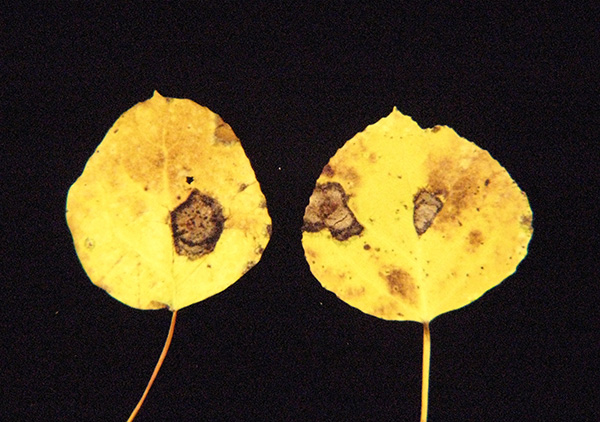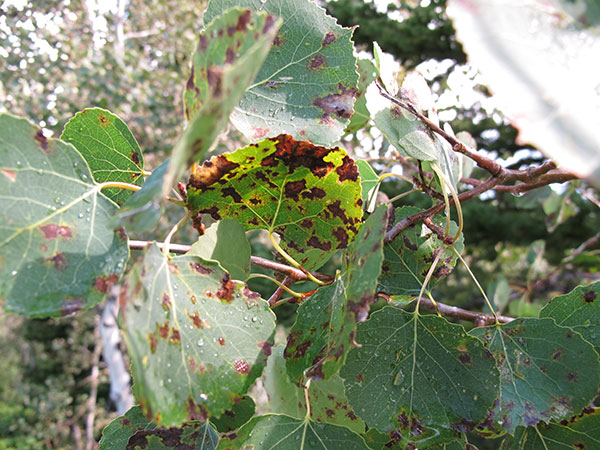Integrated Pest Management
Aspen Leaf Spot
 Classic late season aspen leaf spot lesions, with lighter centers and dark margins.
Classic late season aspen leaf spot lesions, with lighter centers and dark margins.
 Early season leaf spots. Notice chlorotic tissue adjacent to lesions.
Early season leaf spots. Notice chlorotic tissue adjacent to lesions.
Many trees in the genus Populus (which includes aspen) and also in Salix (the willows) are affected by a leaf spot caused by several species of the fungus Marssonina. These trees commonly occur in Utah, and the leaf spot is seen frequently in home plantings and in the canyons and other native habitats. In aspen, Marssonina infections result in leaf spotting and premature defoliation.
SYMPTOMS
Leaves are first infected in early spring. Fungal spores are spread by wind and rain to young emerging leaves where small, dark brown flecks with light centers develop. These spots gradually enlarge and coalesce to form large necrotic (dead) blotches on the leaves. Areas around the dark spots usually turn chlorotic or yellow. Within the infection sites, fungal fruiting bodies called acervuli may form. These produce white masses of spores that push through the leaf epidermis and are easily spread by water to cause new infections.
Leaf petioles and terminal shoots are also susceptible to infection. They develop the same type of lesion. Heavy infections of Marssonina can cause premature defoliation in the spring and again in the fall if frequent rains occur. Repeated spring defoliation in several successive years may result in the death of the tree. Fall infections and defoliation are not considered to be detrimental to the tree.
Quite often, symptoms of iron deficiency will mimic those of aspen leaf spot. In general, iron deficient leaves are lighter green or yellow overall and not just around the dead areas as in leaf spot. Necrotic lesions associated with iron deficiency are usually limited by the veins while those of leaf spot cross over the veins. It is common to see both conditions on the same leaves.
CONTROL
Cultural control options include:
- Rake fallen leaves and compost or discard.
- Prevent sprinkler irrigation from touching foliage.
- Avoid close planting. Allow space for air circulation.
- Prune out lower branches to improve air circulation and reduce humidity.
- Make sure trees are not lacking in iron (use a chelated iron product).
Protective fungicide sprays may be applied at bud break and repeated at 10-14 day intervals as long as wet weather continues in the spring. Dry weather slows the spread of spores so fungicides are unnecessary at these times.

